Fickle June kept changing her tune
Monday, July 3, 2017
Summer at last but what a mixed bag of weather! June can often
be a capricious month but this year it served up something special
with intermitent spells of very warm sunshine and heavy rain and
gales. Although individually each brought their problems,
collectively they ensured unbelievable growth across the gardens,
even though flowering is still somewhat patchy, especially roses
with no full June flush and blooms spoiled mid month by the heavy
continuous rain.
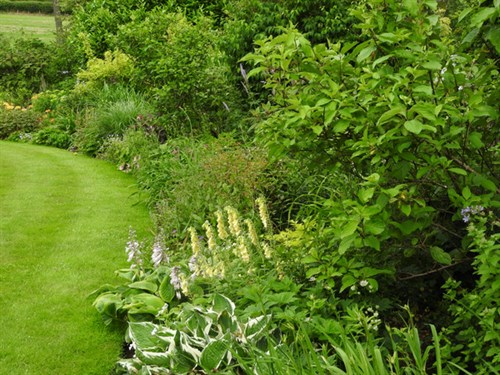
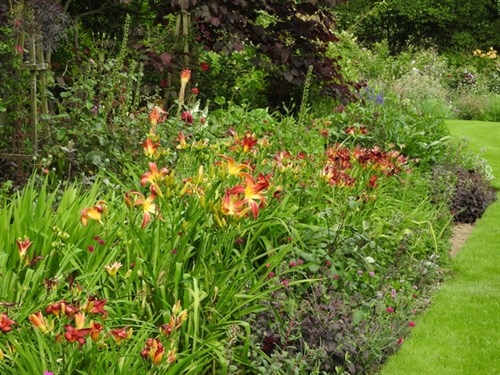
Scarcely a rose to be seen on the bushes at the back of
the large stand of artemesia in the Koi Pond Border
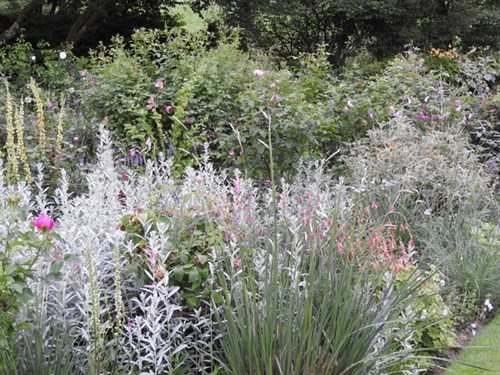
Of course weeds, which we had got on top of, just loved the
conditionsonly so we had to start weeding all over again! This and
all the other essential tasks of the month kept our outings to a
minimum. You forget how quickly the borders can change in
just a few days.
Whilst it has been difficult not to be moved by all the bad news
and doom and gloom in the UK at the present time, plants,
gardens, wildlife and countryside can be wonderfully uplifting, not
to mention the ever changing sky, the greatest free show on
earth.
Something else to lift the spirits is this sown
wildflower meadow at Aberglasney Gardens
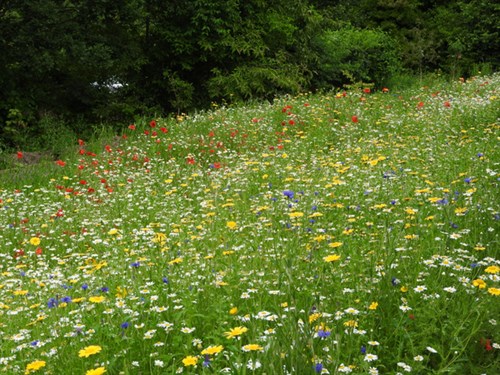
And a little teaser for you - name this plant!
Answer at the end.
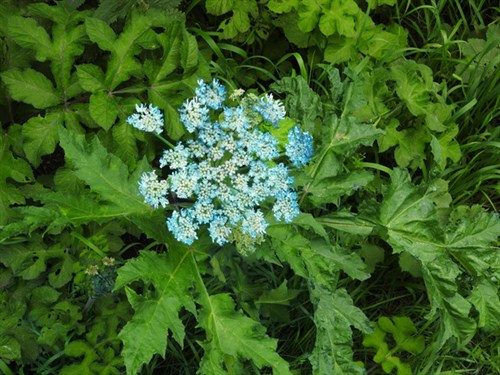
Weather
Variations in the months weather ocurred in cycles which was
quite bizarre, so this month the news report is presented in that
format.
2/6 - 11/6 Mostly rainy often prolonged and strong winds most
days Max 18.9 Min 4
12/6 -22/6 Sunny and warm every day Max 31 min 10
23/6 - 30/6 Changeable Max 22 min 11
Quite a month: warmest June day for 40 years, rainfall higher
than month average and very strong winds at times
A sequence of a marvellous sunset early in the
month
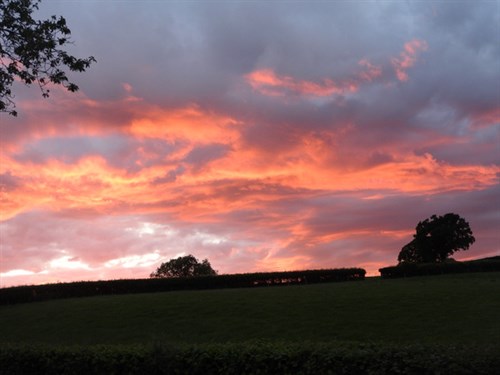
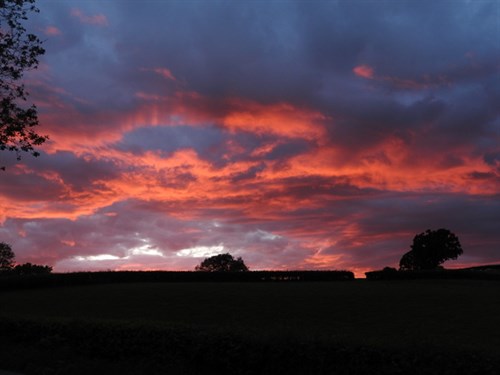
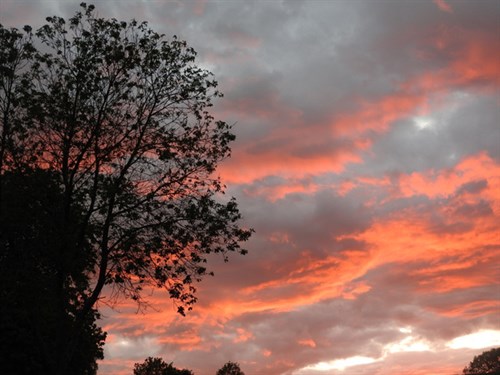
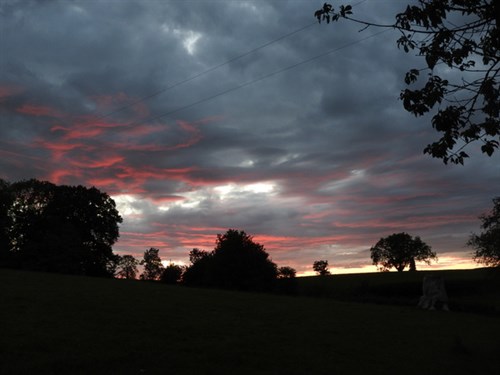
An impending storm brewing
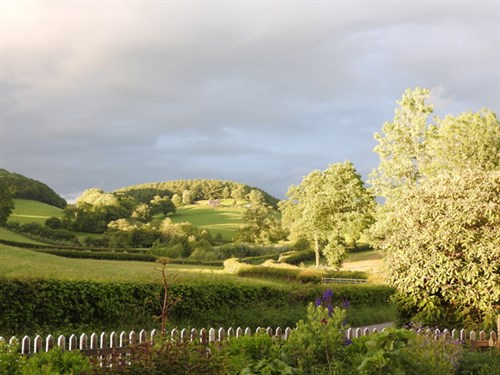
From deep shade on a sweltering day - and what a
blue sky!
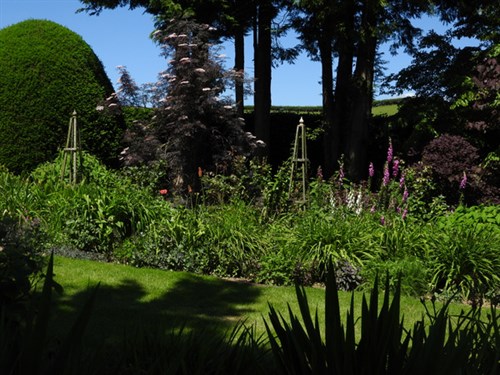
Garden Update
This has to be one of the best and most exciting times of
theyear as the main summer flush begins and the flowering of
herbaceous plants colours up all the 17 borders here. We
commenced planting many of them in 1998 and since then they have
been added to many times over so they are now packed to the extent
that individual plants need less staking because they largely
support each other.
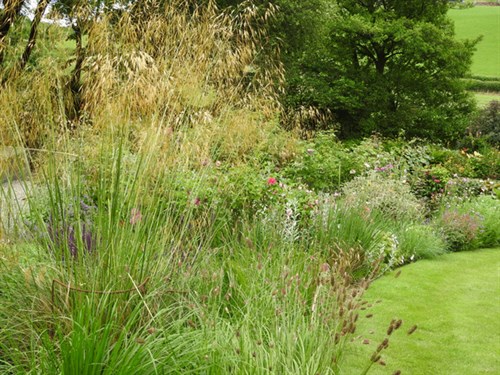
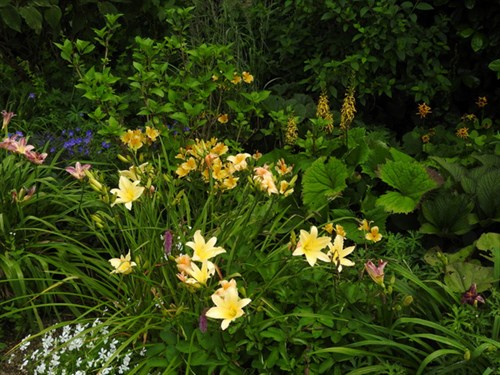
This of course is not generally recommended practice in
herbaceous borders, as many of the more vigorous plants are
supposed to be split and replanted on a regular basis. This is all
very well in commercial gardens but with just 2 of us and a 1 acre
garden, it is simply not possible. If plants are struggling or
severely overcrowded then we do take remedial action and
generally practice good husbandry, but other than that we just let
them get on with it!
With vegetables of course it is a different story: my experience
of growing them goes back over 45 years, and much further than that
as a child of 6 in my parents garden! You have to keep on top of
your veggies throughout the year, practice crop rotation, and feed
and weed them regularly. In what has been a good year so far we
have cropped a range of brassicas, with "Greyhound" as always
the first. The usual mix of salad leaves and lettuces, radish,
carrots and beetroot. No potatoes yet but they are flowering as are
the peas and various types of beans.
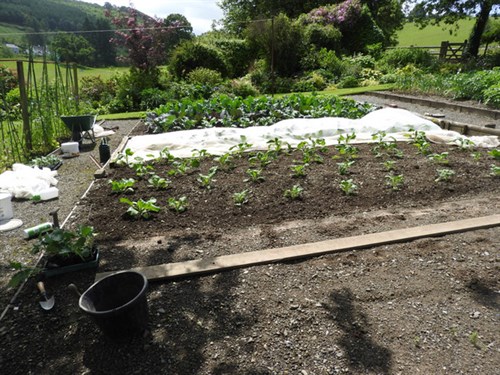
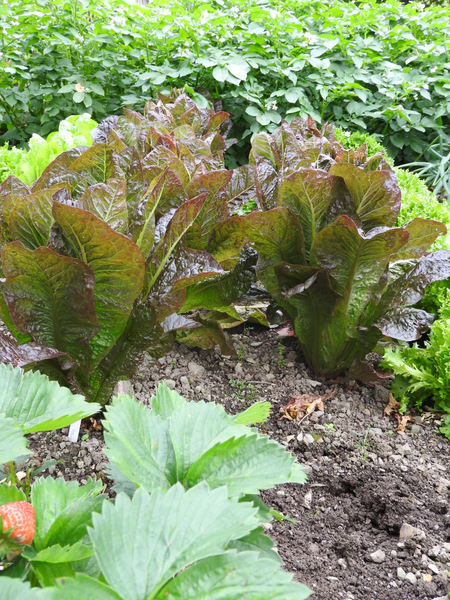
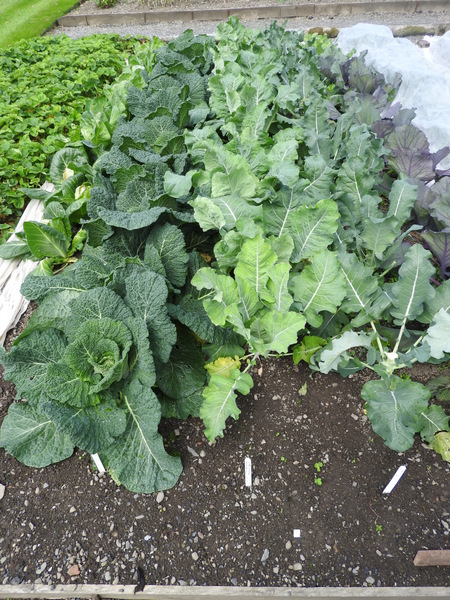
It was not a good year for strawberries with a
poor berry set. One of the reasons for that was explained when
hoeing adjacent brassicas I found stash after stash of berries
stored under the leaves, most likely by rodents!
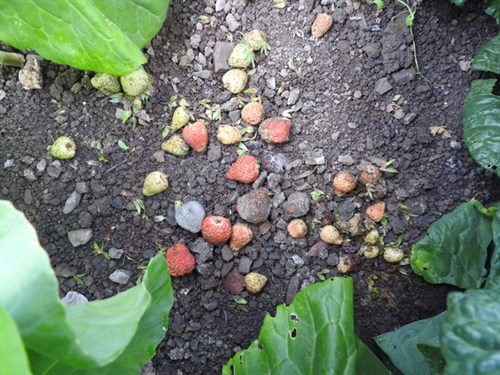
We did have a few feeds with no botrytis for
once. The plants are in their 5th year and will be dug up after
harvest as they are exhausted.
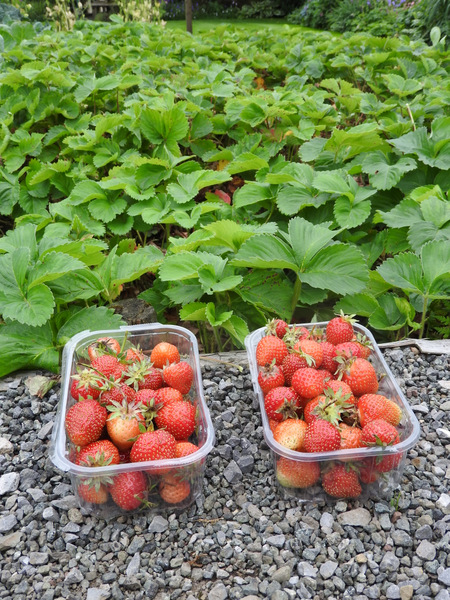
To make life easier for the blackbirds which
somehow get into the fruit cage, the redcurrant saw fly
conveniently defoliated the bush in just a cuple of days! Still
some left for us and a distraction to keep the birds off the
ripening blueberries and Tayberries
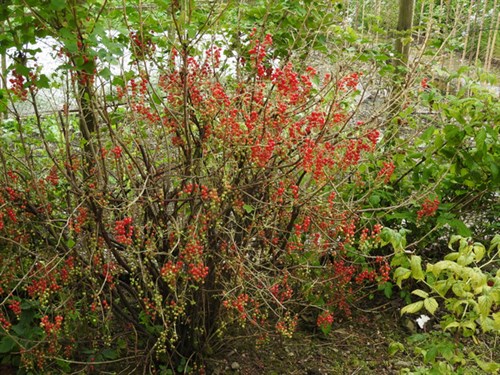
It is good to report that most plants affected by the late
April frosts have begun to recover and should put on a
show, but later than usual and probably
less vigorously.
The 2 cardiocrinums that were falttened by the late
frosts slowly recovered and produced a few flowers but only to a
height of 3 feet, half the normal size. But still that never to be
forgotten perfume. You marvel at the recovery powers of plants: no
wonder they have been around for so long.
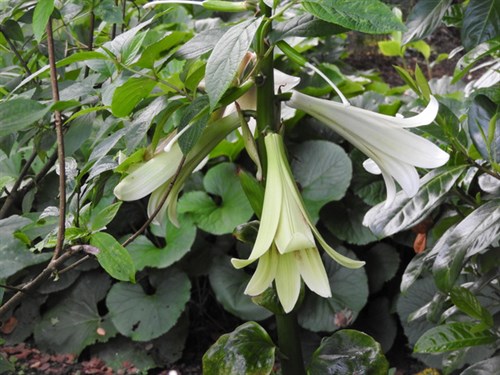
The regular disease and pest suspects have taken advantage
of the weakened state of plants caused by those frosts, and seem
more in evidence than usual. Chief offenders are white, black and
green flies, capsid bug on dahlias, impatiens, asters, fuchsias,
hydrangeas, monardas and brugmansias, (which are also showing
signs of red spider attack since last week's heatwave).
Hemerocallis gall midge has made its usual appearance but damage so
far has been limited to only the the terminal flower buds.
Rabbits too are plentiful despite the best efforts of Kit
Kat
Capsid bug damage on a dahlia
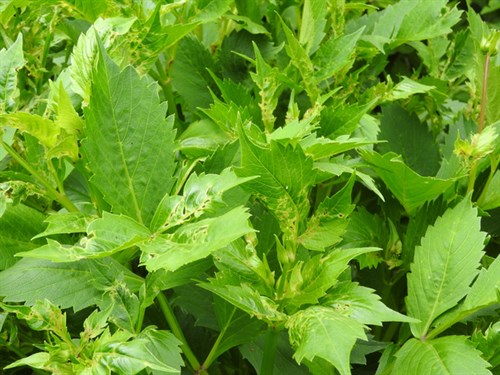
And on impatiens tinctoria
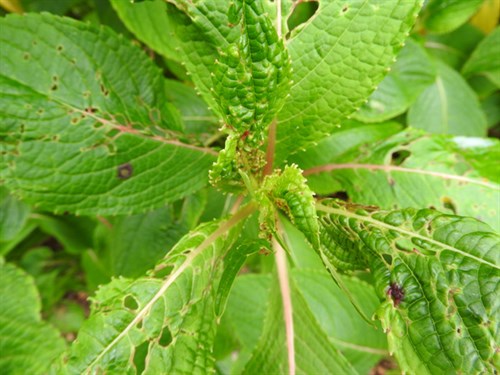
Black spot on roses early on was quite severe, especially
David Austin cultivars, but a spraying regime has brought it under
control. I know that will not appeal to some readers but it is the
only way to grow good roses here in mid Wales.
One of the few of over 80 roses to flower in mid June,
R. "Jacqueline du Pre". Pure white flowers with red stamens and a
gentle perfume. A tribute rose for the great cellist.
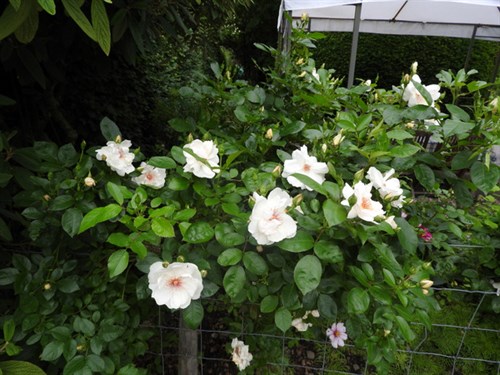
And what is a garden in June without the
scent of massed plantings of roses, sweet peas, philadelphus and
honeysuckles in variety, and best of all the wonderful
cardiocrinum giganteum - the so called Himalayan lily. Oh and I
nearly forgot the coming into flower of the first brugmansias in
the tunnels, at their best after 6.00pm on a balmy summer night, 4
large 7 feet plants in shades of white, yellow and pink.
Philadelphus "Belle Etoile" for me the best scented form
I have smelt and reasonably compact
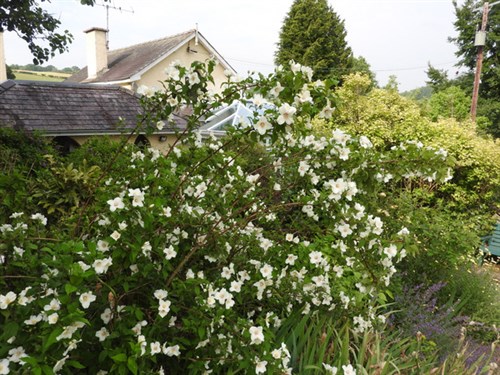
A variegated and rare brugmansia "Miners Claim" in
a pot in the conservatory border
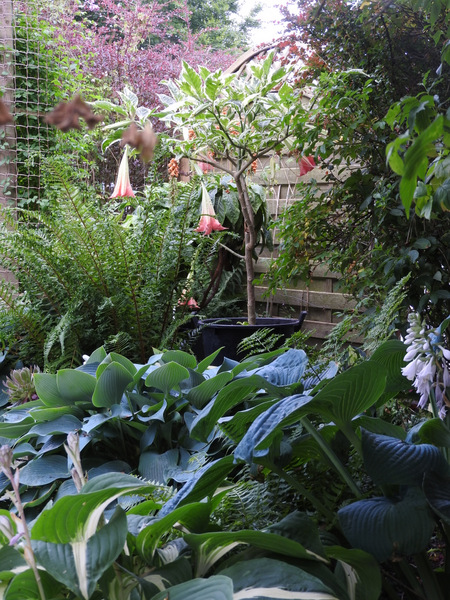
Sweet peas need no introduction
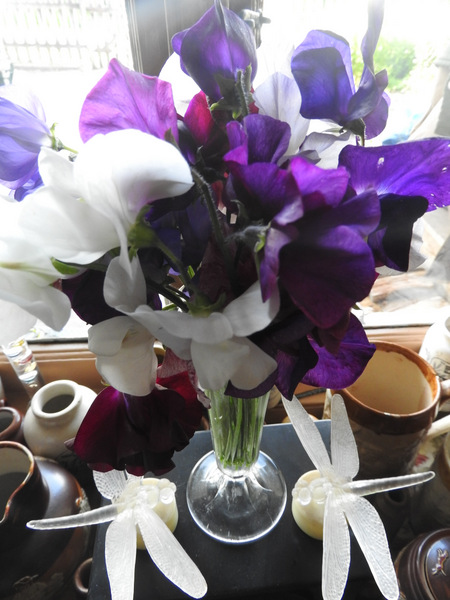
Unfortunately for the 3rd year in a row most
of the plants have turned yellow in spite of regular watering and
feeding. I am afraid it might be fusarium wilt for which there is
no cure.
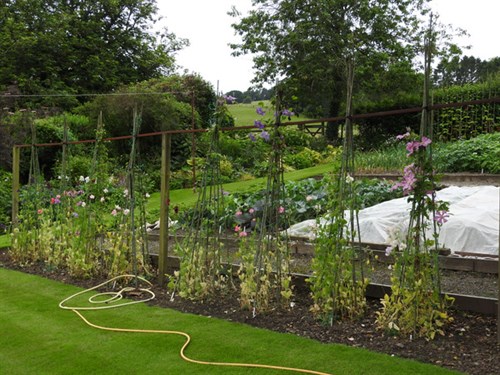
From a very early age living alongside a canal and
river I have enjoyed messing about in the water, and still a
favourite job of mine is to clear out excess pond weed from the
Paddock Pond, in full chest waders, giving me a human's eye view of
the many fish and other pond life, and a chance to inspect the
water lilies in profusion now coming into flower, and to cut back
any otherwise inaccessible overhanging branches.
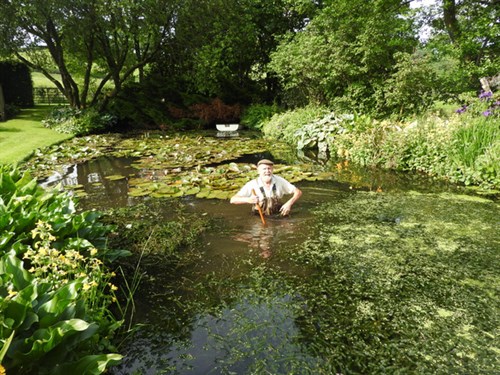
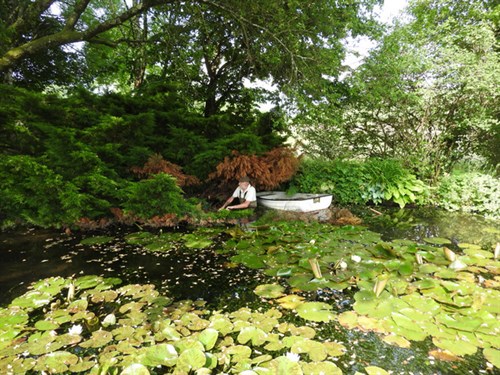
Piles of pondweed are left on the bank overnight to let
the pond creatures return back to the pond. It makes excellent
compost
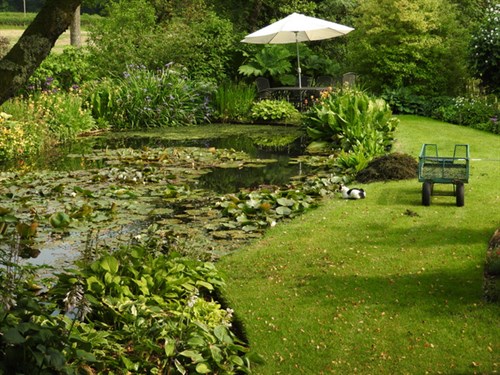
There is always work in the tunnels, greenhouse and
nursery, especially with watering regularly in tempreatures to 46C
in the large tunnel. In these temperatures even tropical plants
suffered and some were badly scorched.
At times like this you need all the help you can get!
Part of my large army!!
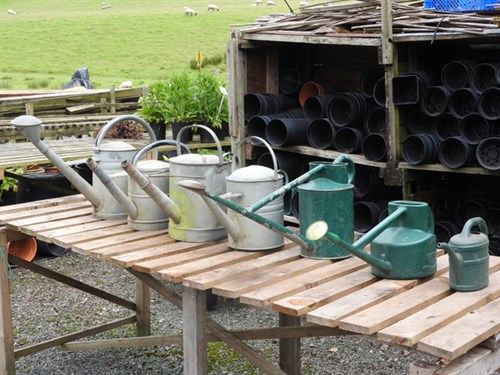
What's looking good?
As usual a gallery of pics of some of the very best , with so
many to choose from, but the star has to be the hardy
geraniums, a true hardy plantsman's plant if ever there was
one.Summed up best of all by Margery Fish many years a go who said
if in doubt what to plant where, plant a geranium!
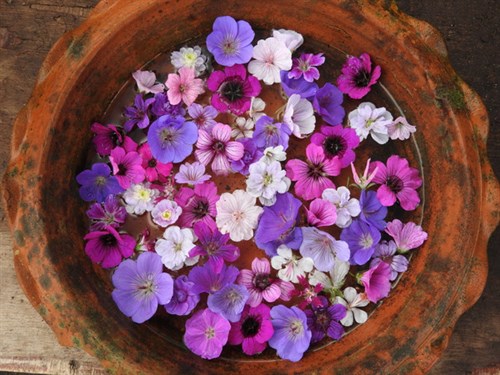
The 3 large ones at the front of the dish l to r are
"Rozanne", Lakwijk Star" a rare wallichianum hybrid and the white
flower of macrorhizum album from a late flush
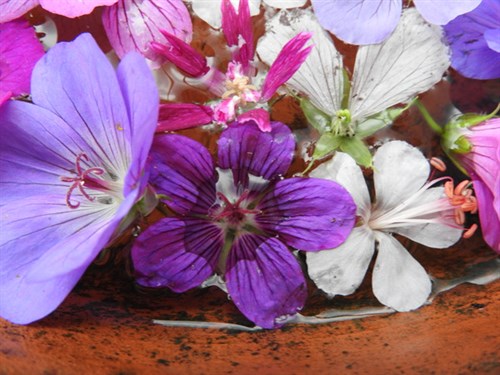

Another striking array featuring numerous pratense forms
and in the centre the pink rayed flower with dark eye is the superb
form "Sue Crug"
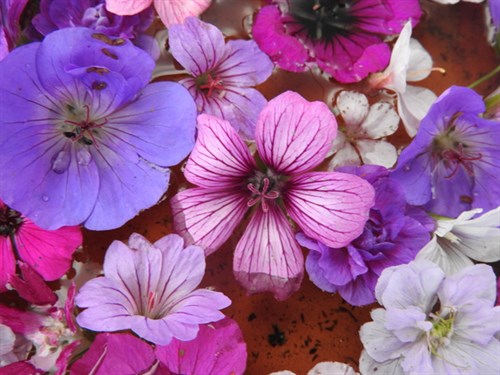
One of the first geraniums I bought is pratense
"Mrs Kendall Clark"
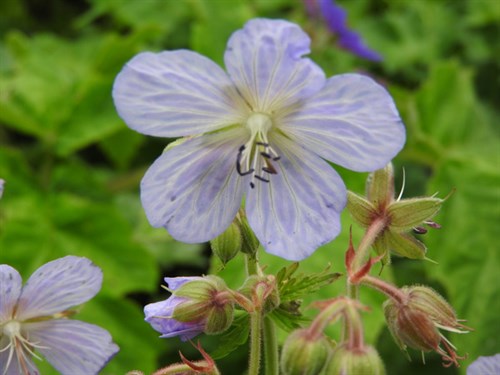
And another real good doer is G. "Magnificum" a
long established favourite in many gardens.
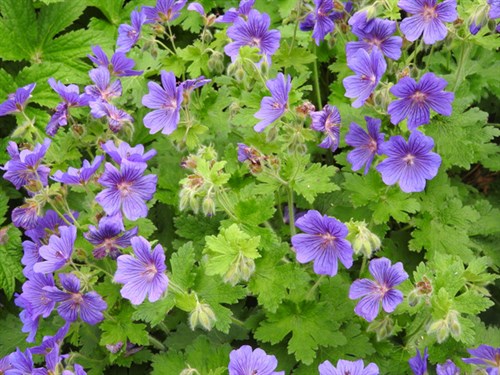
Daylilies - hemerocallis are a great favourite and one
of the major contributors to the late June/early July border. There
are over 70,000 cultivars to choose from plus some species
forms
A special one to me is this spider form grow from seed
donated by American Hemerocallis Society members . Its flowers are
larger than my outstretched hand
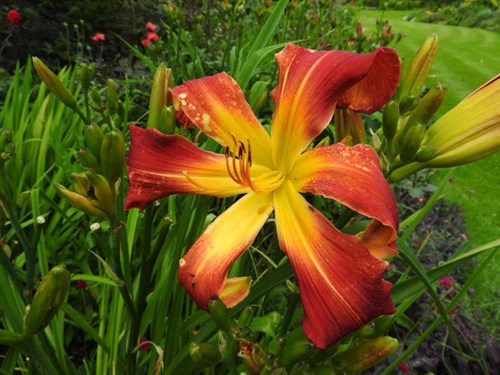
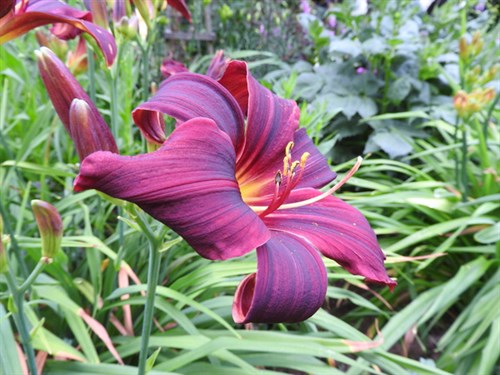
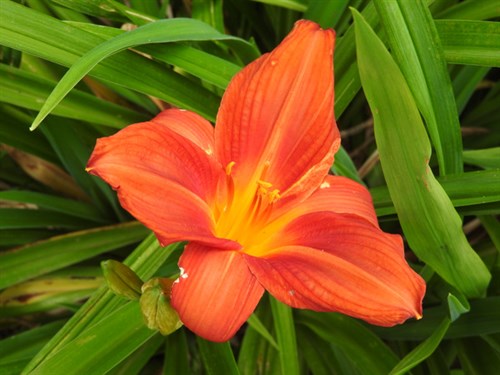
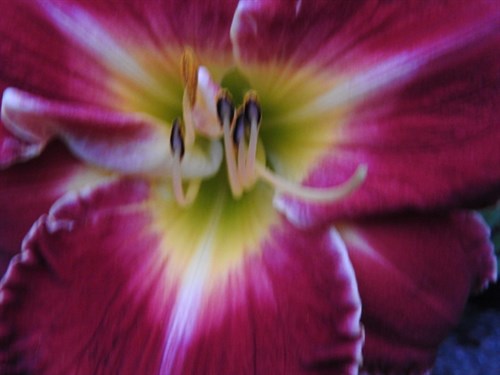
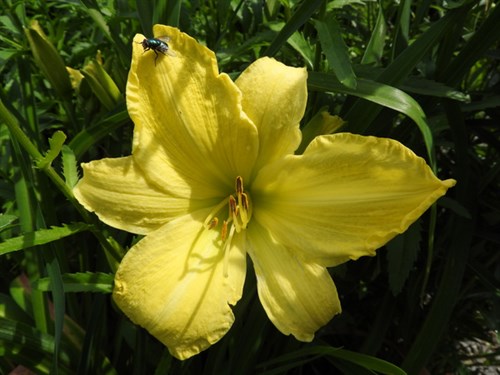
In total contrast to the "Hems" are are arisaemas,
a woodlander and specialist plant for shade and humus rich moist
but not too wet soil. They grow from tubers with archtectural
leaves in all shapes and sizes and mysterious hooded flowers that
give the plant its common name of "cobra lily" I have my friend
Tony Marden, who specialises in them at his nursery
shadyplants.com, to thank for introducing me to them, rather
reluctantly at first! They have grown on me and I like the
challenge they present to place them in the right spot in the
garden.
Arisaema ciliatum var. liubaense, the flower, white a
white stripe is lurking in the shade
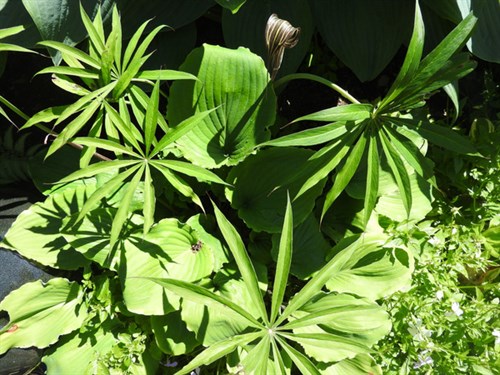
A. costatum mixing comfortably with other shade
lovers
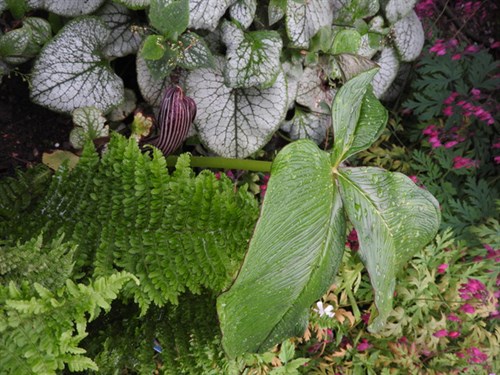
A. candidisimum at Aberglasney, a challenging form to
grow well. I have tried it several times without
success
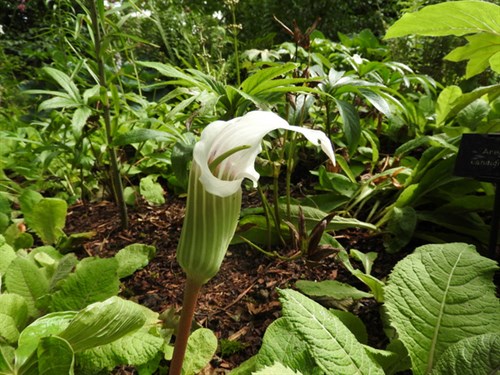
A. speciosum is a tall and impressive form with an
attractive mottled stem. Like many ariasaemas the flowers are held
lower down the stem
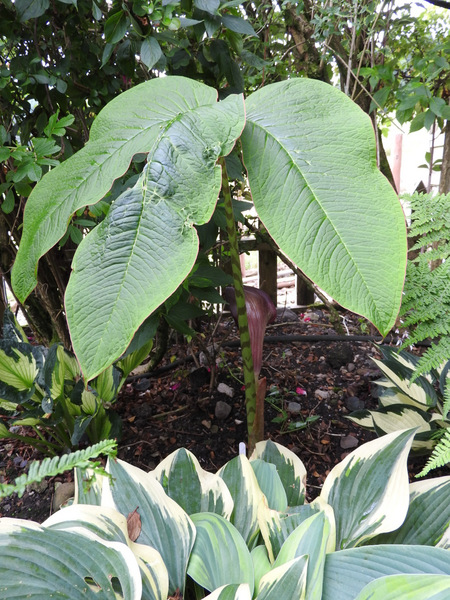
Another tall form is quite a mouthful; A.
exapendiculatum with a striking green and white striped flower that
comes straight out of the stem which lends the plant its
name.
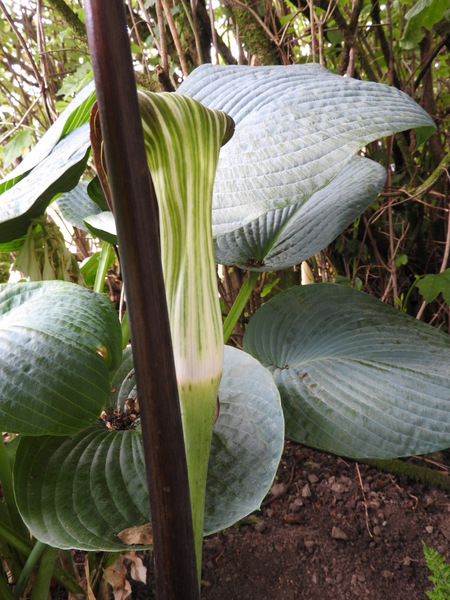
Arisaema leaves of several plants showing how they
continue to make a contribution to the border even when the flowers
can't be seen or have faded.
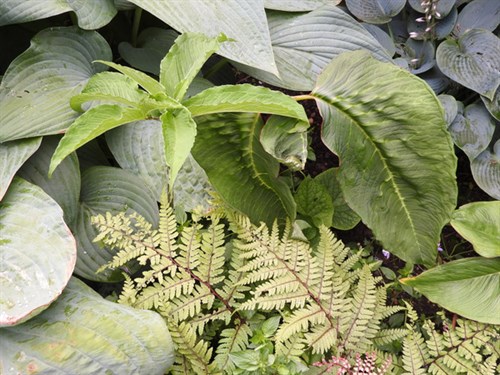
Something very different are the vivid yellow flowers of
oenothera "Firewoks" which makes a tidy clump to 2.5 feet and
unlike some evening primroses does not seed around.
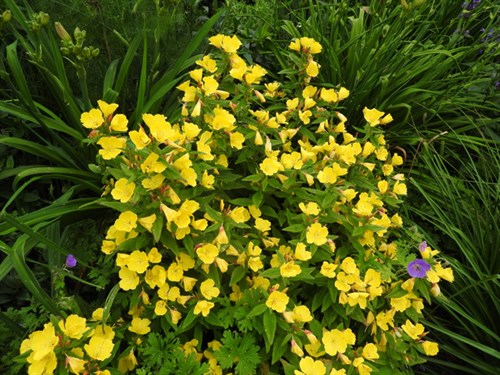
Like firework sparklers this tender perennial NZ
beauty, arthropodium cirratum, does really well when cascading over
a tallish pot, Needs frost free protection and will make a
sizeable plant if potted on each year in early spring. Very easy
from seed.
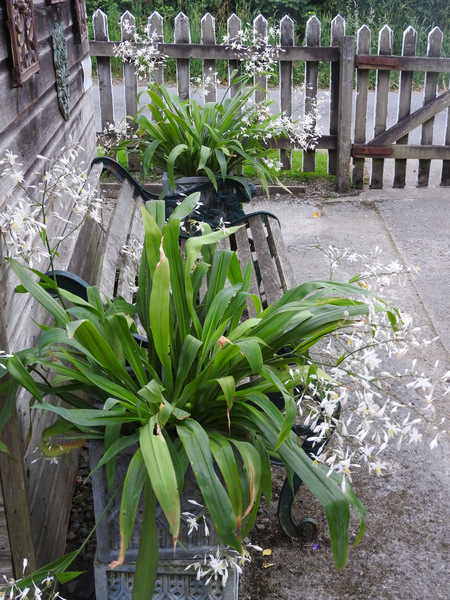
Wildlife and
countryside
Some very happy farmers around here as the fine weeks gave
the perfect opportunity to get in the grass harvest - and even to
make some hay which is particularly choice when taken
young.
Many of the lambs have gone to markets and the fields are much
quieter now as their mothers have a welcome break before the cycle
begins again in September
On the birdlife front, at the beginning of the month I was
pleased to see the return of redstarts to the gardens and along the
lanes. Sadly no sign of pied flycatchers which were regular summer
visitors here, nesting in bird boxes, up to 3 years ago, since when
I have not seen one. A bird doing well is the bullfinch and several
pairs in the garden have each raised a brood. Mistle thrushes
are more common than for some time and always seem to find a way
into the fuit cage, even though I have failed to find any gaps.
They seem partial to redcurrants and the saw flies have done them a
favour by conveniently defoliating most of the bush!
Our very special and now regular visitor comes around
the conservatory at about 8.00pm each night and makes for the
border where cat treats await him. So rare now its a privilege to
see one so close to home.
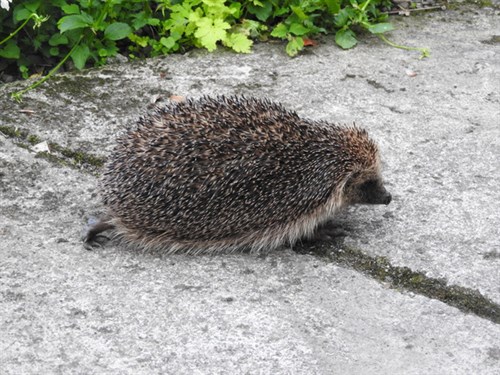
I have mentioned before the wildflower interest all
along the A40 in Carmarthenshire on verges, adjoining embankments
and roudabouts which makes them difficult to admire close up and
even more difficult to photograph!! The ox eye daisies have been
spectacular all through the month.
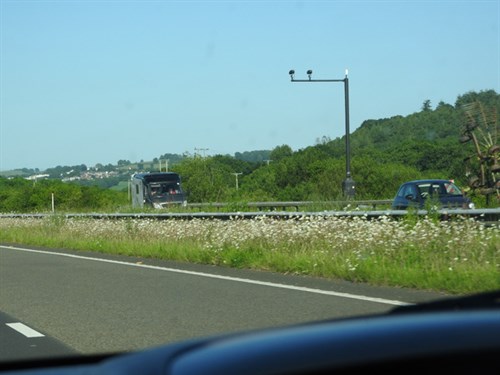
But we don't have to venture outside the front
gate to see wildflowers in the gardens and right up against a stone
shed is a good stand of self seeded prunella vulgaris or "self
heal" in many country areas
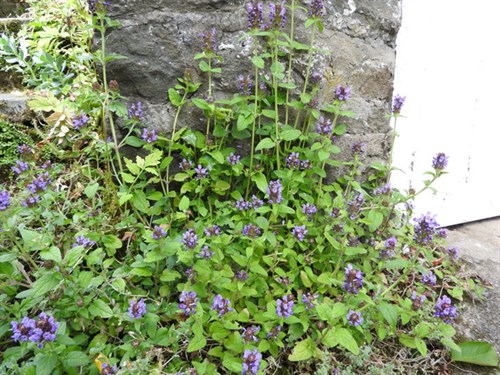
Visits
With so much more to do at home we have been out and abut only a
couple of times to venues old and new.
Llanllyr, Temple Bar, Ceredigion opens by arrangement
for the NGS. Situated on the site of a mediaeval nunnery it is a
fascinating and atmospheric garden with a surprisingly good range
of plants and habitats
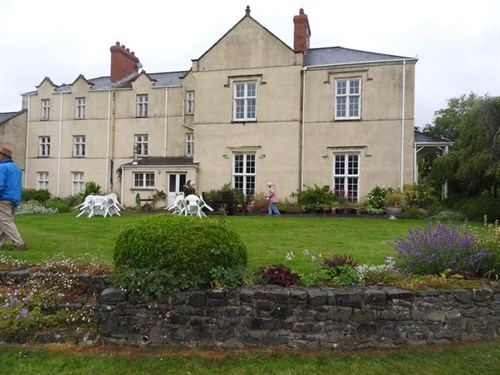
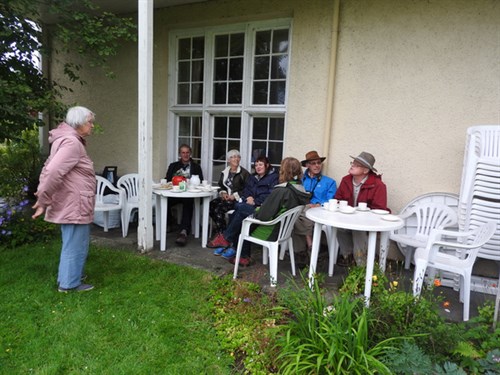
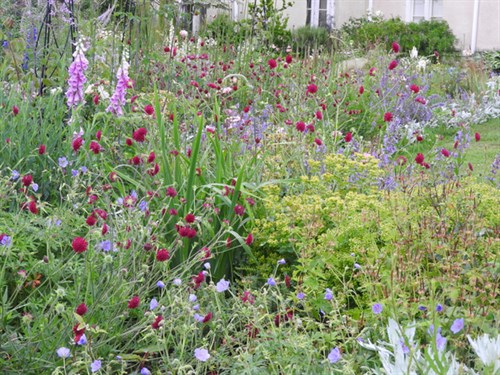
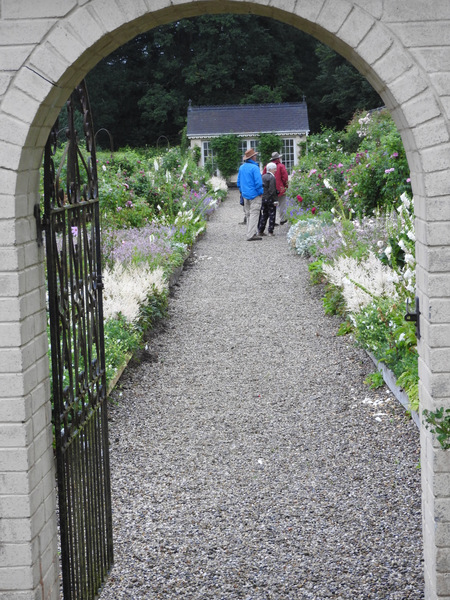
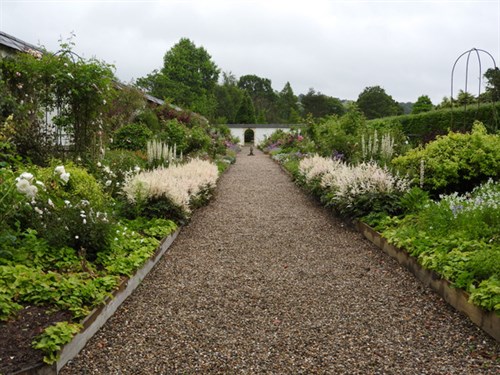
Another old garden is Aberglasney, the nearest
garden to us which is very fortunate because it demands regular
visits throughout its opening period which is every day except
Christmas Day.
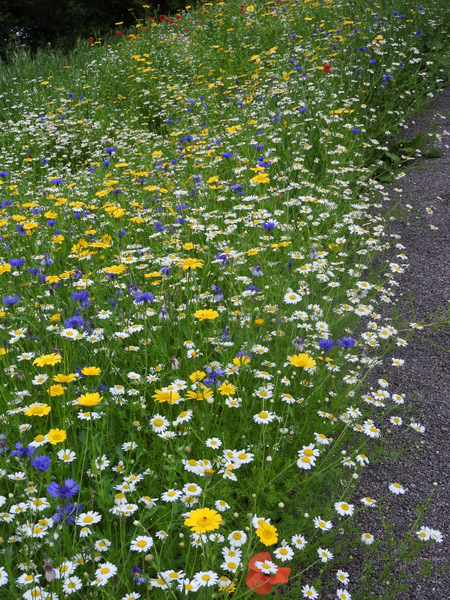
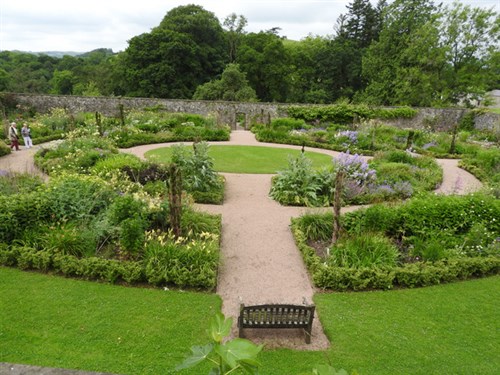
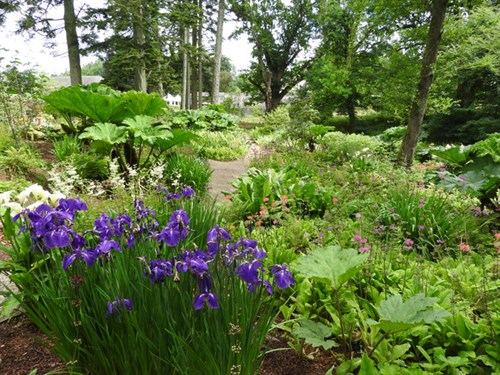
In the sunken garden was this brilliant bronze
coloured lily called Grand Cru, an asiatic hybrid
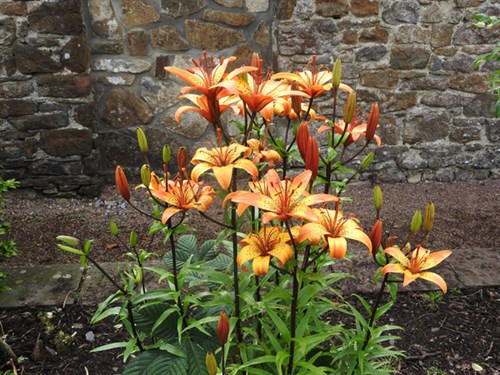
Our final gardens visit was a coach trip with South
Wales Hardy Plant Society Group to Somerset. Elworthy Cottage
garden and nursery in the morning and Yeo Valley in the afternoon.
2 very different but perfectly contrasting gardens
Yeo Valley was a complete surprise because none of us
knew what to expect. In rolling countryside and with views of the
nearby Blagdon Lake it is on a suitably grand scale and brilliantly
planned and planted with some great ideas to take
away.
The Gravel Garden in a limited but imaginative colour
palette is sculpted into mounds which break up the flat elevation
of other parts of this garden, echoing what we saw last year at
Keith Wiley's Wildside garden, altough the planting there is quite
different.
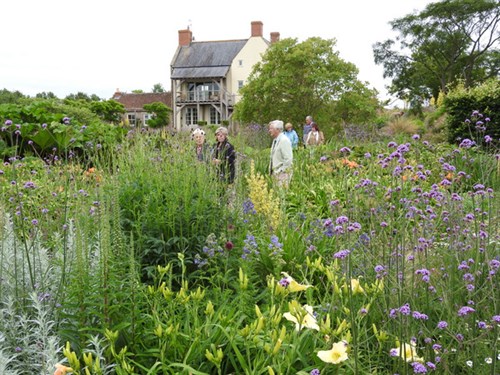
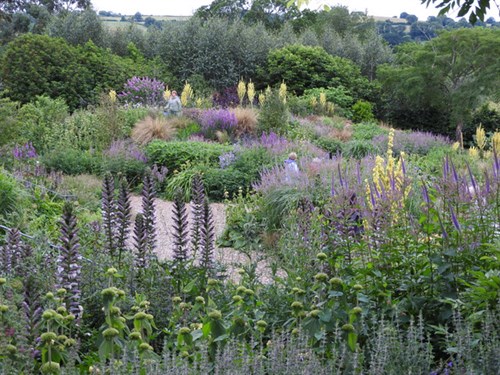
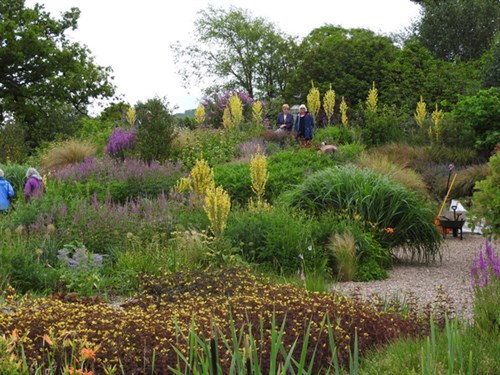
As a complete contrast you pass into the cooling shade
of a glade of dozens of
white stemmed birch underplanted with ferns. It makes a huge impact
even though still rather young.
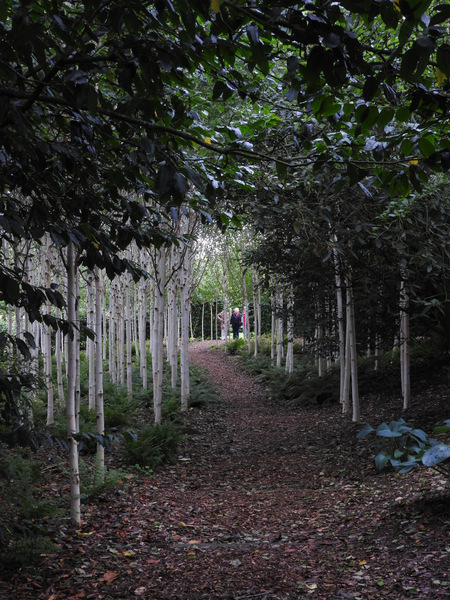
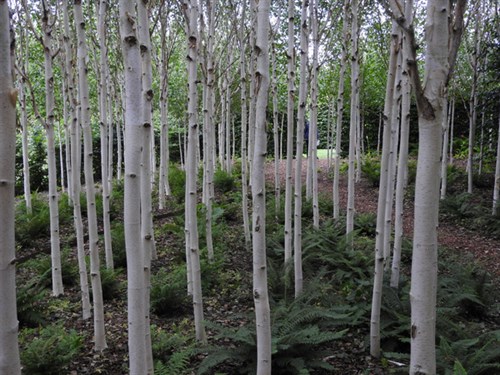
From that you pass into the Bronze Garden, a contrast
again with some lovely touches and superb colour combinations all
on a bronze theme. Strong design lines too.
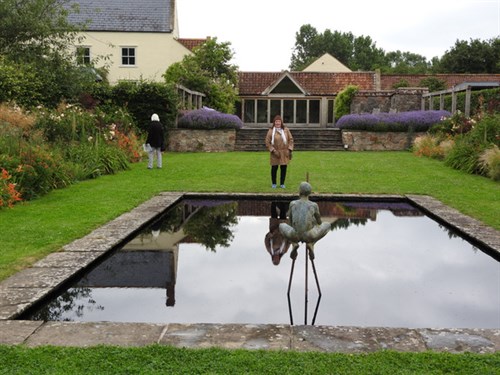
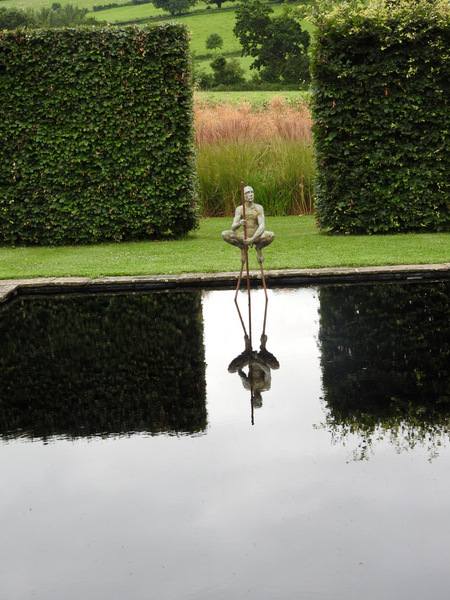
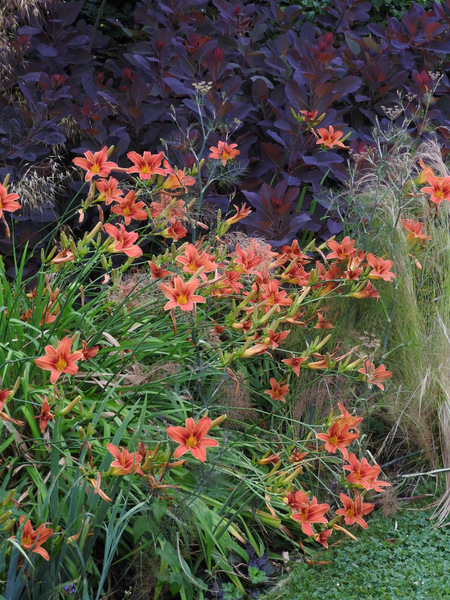
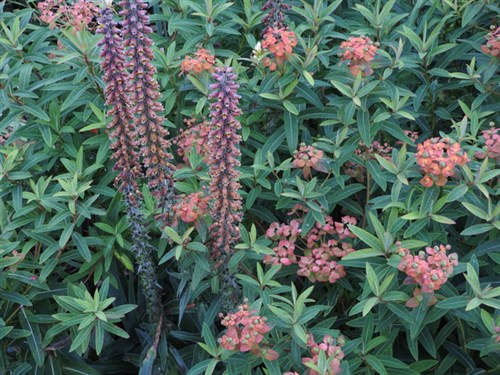
And finally no hardy planters ever go home empty
handed! More plants to find room for!
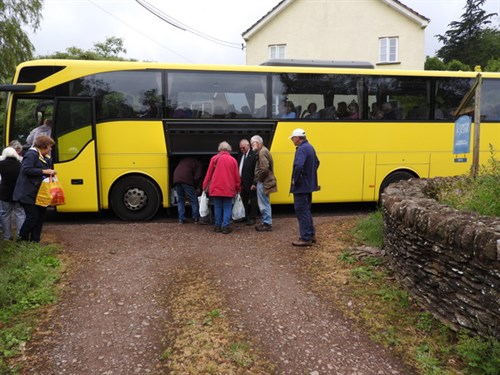
And finally the answer to that mystery plant. If you got
it right well done. Not easy by any means. It is the flower head of
a giant hogweed alongside that famous Carmarthenshire plant highway
otherwise known as the A40! Normally white the flowers, in a group
of plants, had been sprayed by local council workmen to identify
them for subsequent weedkilling. It is an extremely toxic plant and
owners of land on which it grows have a duty to erradicate it.
Shame in some ways as it is an impressive plant with stems up to 10
feet.
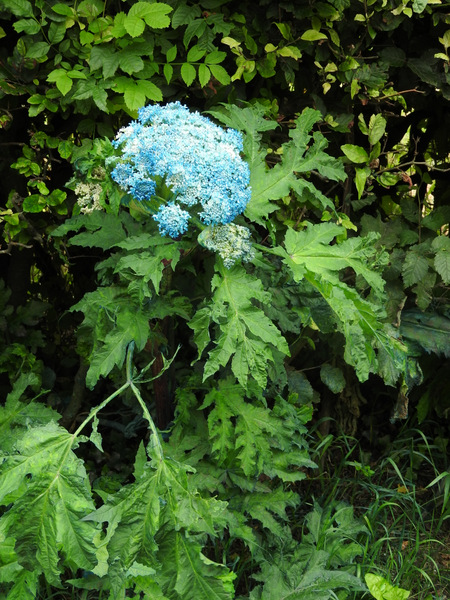
That's all folks, thanks for reading and have an enjoyable
summer.